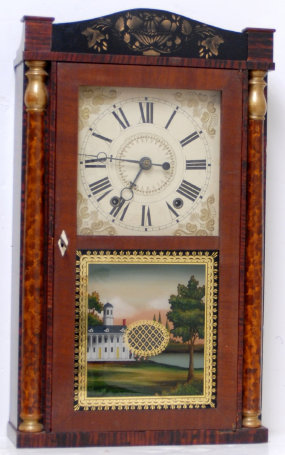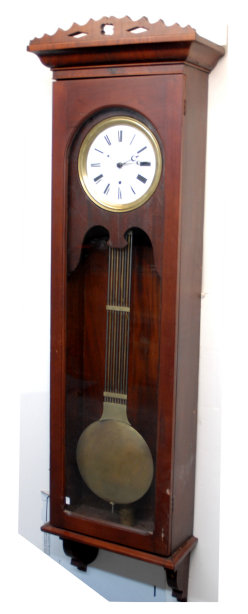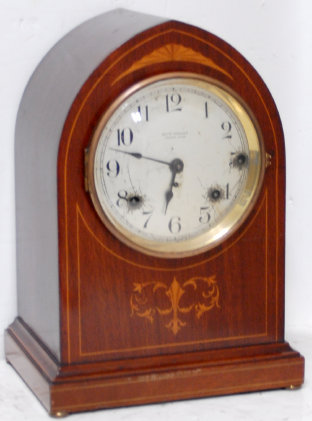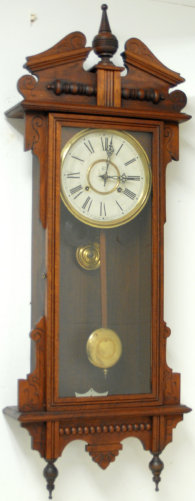257. $150
“Eli Terry, Jun’r / Plymouth, Conn.”, column and splat shelf clock, ca 1831-1835. Backboard label is near complete and reads, “Patent / Eight-Day Clocks, / Invented By / Eli Terry / Made and Sold/ At / Plymouth, Connecticut, / By / Eli Terry, Jun’r”. This is a 30-hour weight clock, wood movement, in a small 24-inch-high mahogany veneered case. It is in operating condition and has the original wood movement. A large brass bell is below the movement. The rosewood veneered case is near perfect, top glass is old, bottom is a replaced painting by Tom Moberg. The case has half columns and a splat, all with very good stenciling. Excellent wood dial with good paint, no chips or cracks. There is a working door lock with escutcheon and a key. Identical clocks are pictured and described in the book, “Eli Terry and the Connecticut Shelf Clock”, Second Edition Revised, by Kenneth D. Roberts and Snowden Taylor. $200-$350.

258. $1000
Scottish round head tall clock, “T Middlemass / Edinburgh”,
ca 1820. Mahogany veneered case is stunning with a carved crest, two full doors both, door over dial is hinged at the top, no lock,
the large door has a key lock with key. The case stands 82 inches tall and is 18 ½ inches wide. There are no wood splits as is so
typical of Scottish and English clocks. It has nice turned feet on the bottom. The 8-day two weight movement is removed from the case
by removing the bonnet. The iron dial is 12 inches, has good paint that is still holding and with no wear. We are not sure the four
hands are original. The clock strikes hourly on a bell. We are not sure that the calendar function is operable, they so seldom are
and we did not verify. It appears the second hand is not operating. The two large iron weights are about 15 pounds each and compounded
inside the case. The iron pendulum bob, brass pulleys, and other case hardware all seem to be original to the case. We note on the
internet that a clock like this used to sell in the United Kingdom up to $12,000 and more. We have sold several over the years and
notice they are more popular with collectors than the normal English tall clocks. This clock has to be the nicest Scottish clock we
have ever sold. $1000-$2000.

259. $1500
Swiss pinwheel regulator movement in a 77” high walnut case,
ca around 1890. The 8-day Swiss movement is typical of many others we have sold over the last 45 years. The large lyre pendulum and
weight are like most others we have sold. We have routinely sold the Swiss pinwheel movements with pendulum, and without a case, for
at least our minimum on this clock. In addition you get a very nice and clean case, 77” high, and 24” wide, and it is plain as most
pinwheel cases are. I cannot vouch for the origin of the case, as it was probably made by an American factory or good American cabinetmaker.
Rarely did a Swiss pinwheel come from Europe in a case. The dial board and several places around the case have grooved designs and
the door edge is beveled. There are two door latches, no lock, the top is pegged. The porcelain dial has a tiny repair on the edge
of the dial at 5 o’clock. The dial board is held to the case with four screws. The hands, weight, and large brass pendulum are all
original to the movement. The 8-day movement is clean and running. $2000-$3000.

261. $450
Watchmans Clock. “Burk’s Original Drum Clock”, a 19th Century German Portable Watchclock, ca 1861. It comes with a printout about this type clock which I assume is available on line. Some were made with porcelain dials, and the printout says they were reproductions. This clock is all metal, very small for a Watchman’s clock as the diameter is only 3 inches. The outside case is brass, has a hinged top, a winding key, and a large ring on top I assume to hook it on your belt or something. These Watchman’s clocks were made for many years with lots of alterations and different recording mechanisms. We found some sales of the Drum Clock but they were made post 1900. Pre-1900 models are hard to come by. $500-$1000.

262. $150
Lenzkirsch wall clock that is different than anything you have
ever seen. When I think of Lenzkirsch I sure don’t think of them making tiny clocks like this one. It has all the trappings of their
big clocks, i.e. key locking door, beveled oval glass, recessed dial glass, extra nice pendulum bob, large coil gong, porcelain dial,
seatboard for movement, signed movement, signed gong base, wall levelers, and signed case. The mahogany case is only 16 inches tall,
and in excellent condition. The 8-day movement is running and striking. $200-$350.

263. $300
Seth Thomas Clock Co. “Chime Clock No. 64”, ca 1914. Housed in a mahogany cabinet case with shaded marquetery, it has 5 bells and plays Westminster Chimes every fifteen minutes. The chime can be silenced leaving the hour only striking. The full case back door has a mesh covering that allows the chime sounds to escape the case body unimpeded. The case is 14 inches high, clean and polished, with less than normal wear for a metal case of this type. The dial is silvered with etched numerals and cut serpentine hands and is signed two places. The dial has average wear and better than most silvered dials on the Sonora Chime clocks we have handled. The clock is identical to the one pictured on page 156 in the Seth Thomas Clock Co. book by Tran Duy Ly. The chime movement is numbered “90B”, and the running movement “90/0”. It is running and striking properly on the five bells. $400-$600.

264. $250
Waterbury Clock Co. hanging walnut cased clock, “Eton”, ca 1906. Clean walnut case is 39” high, has the original finish that has been only lightly cleaned to remove any smoke. It is nice so I would assume it has been polished and has always been in a situation where folks enjoyed the clock and took good care of it. It has an excellent label inside and a factory etched number “20”. There are parts of two labels on the back. The movement is spring driven, signed by Waterbury, running, and striking a gong on the half hours and hours. The original painted dial is signed two places, hands and brass rings are original, so are the gong, brass bob, and wood stick. In the bottom is a signed porcelain beat scale. This clock is about as original as we ever have come into our place. If you like original this is a good one. Ly-Waterbury #581. $300-$500.

265. $200
Seth Thomas Clock Co. wall clock, “Globe”, ca 1921-1928.
This case is made with what ST called “quarter oak” and it stands 32” high. It has the original finish with moderate crazing. It has
not been overly cleaned or polished, and in my opinion does not need to be cleaned. The clock is all original with one exception,
and I am not sure that Seth Thomas did not make the dial for “Dingwall’s”. Note the hour time ring and the inner ring that is numbered
1 thru 10?? I cannot find a reason to say that Dingwall’s is an American company but I can find hundreds of reasons to say it was
an English company. The dial, brass dial ring, and hands, are all original. The dial has very good paint. A complete paper label is
inside on the backboard. The movement is 8-day time only, signed, and running. Great brass bob and wood stick. Nice clock that generally
sells around $750. Ly-Seth Thomas, page 322. $300-$500.

266. $200
Waterbury Clock Co. banjo, “Willard No. 2”, ca 1906. Mahogany
case is 42” high, has all the balls and finials, good original painted glasses but the throat glass is flaking on the outer edges.
It has cast gilt trimmings that include the sash and rails. A good part of the Willard No. 2 paper label is on the back. It has a
correct Waterbury brass pendulum bob and wood stick. Bowed glass over the porcelain dial, and has the original hands. The dial is
near perfect, and the clock overall is excellent with one exception, the metal baffle board is missing, which means also no pendulum
tie down. It no doubt has the normal nicks and wear after 100 plus years of use. The 8-day weight driven movement is a timepiece only,
running, and signed. It has the proper original iron weight and porcelain beat scale that came with the clock. Clock books today over
$1500. I am not a repair guy but it seems to me with little effort this could be a valuable clock. Ly-Waterbury #122. $300-$500.

267. $200
Waltham Clock Co. miniature Willard style banjo, ca 1930. The case is only 21” high, has a nice finish all over the mahogany case. Mahogany stained wood balls around the base, three perfect glasses, brass sash with flat beveled glass over the ivory painted metal dial. The dial is signed and is in excellent condition and has the correct hands. It has good brass side rails and a brass eagle. The 8-day time only movement winds and sets by turning a long brass rod behind the door on the base. It is time only and running. We sold this clock in the July2018 auction but it was returned because of a split on the top. Splits on round top clocks are very common and many banjo clocks, calendar clocks, and some shelf clocks have those splits. Ly-American Clocks #912. $300-$500.

